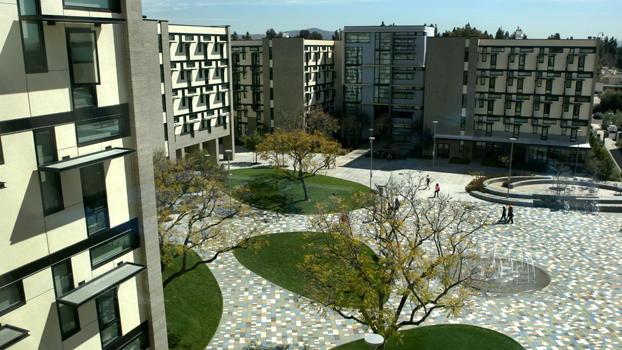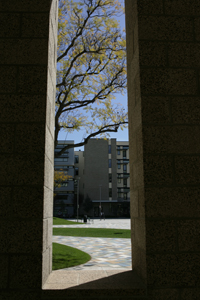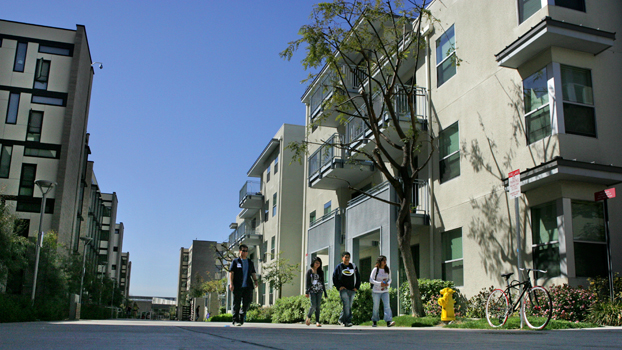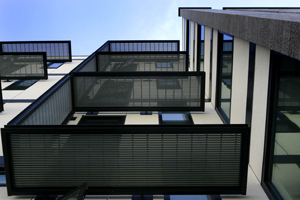 Caption: Energy-efficient windows with sunscreens are one of the features that won the new student housing Platinum (LEED) certification by the U.S. Green Building Council. Photos: Karen Tapia Download Image
Caption: Energy-efficient windows with sunscreens are one of the features that won the new student housing Platinum (LEED) certification by the U.S. Green Building Council. Photos: Karen Tapia Download Image
Leading California
State’s First Platinum LEED Ranking for Student Housing at CSUF
March 28, 2012
Cal State Fullerton’s newest student housing complex is a step ahead of any statewide — it is the first in California awarded the Platinum Leadership in Energy and Environmental Design (LEED) certification by the U.S. Green Building Council.
The council’s platinum certification is verification that a building or building project meets the highest in green building and performance measures. LEED is the nationally accepted benchmark for design, construction and operation of green buildings.
“We’re very proud of this project, which is the largest construction project undertaken on campus in terms of cost, size and scope,” said Jay Bond, associate vice president for facilities management and campus architect. The $143 million project “was designed to provide students with a full residential experience, and it does so while being energy efficient and sustainable.”
 Caption: The view along a walkway in the new student housing complex. Download Photo
Caption: The view along a walkway in the new student housing complex. Download Photo
Completed last summer, the complex is located just south of the campus’s older residence halls. Its cluster of five, five-story structures arrayed around a piazza provide housing for more than 1,000 students in double-occupancy rooms, alongside a 571-seat dining hall. The eye-catching Gastronome, with its indoor and outdoor seating areas, is where students and others from throughout the residential and greater campus community come to dine. Other facilities include a convenience store, laundry area, mailroom and meeting room.
The LEED certification is based on a number of components that include sustainable site development, water savings, energy efficiency, materials selection and indoor environmental quality, said Stephen Chamberlain, senior project manager in Cal State Fullerton’s Office of Design and Construction.
“In the area of landscaping, we used native, drought-resistant plants, along with a drip and subsurface irrigation system that reduces potable water usage by 50 percent,” he noted. “The landscaping also helps mitigate storm water runoff by diverting the water to rain gardens and bioswales, which absorb and filter water before it reaches storm drains.
 Caption: An example of the drought-resistant plants used to landscape student housing.
Caption: An example of the drought-resistant plants used to landscape student housing.
“Water-conserving plumbing fixtures, including high-efficiency toilets, low-flow lavatories, urinals and shower heads will save more than 2 million gallons of water per year,” Chamberlain added. “And a single-ply ‘cool white roof’ type membrane was installed to help reduce building heating and cooling loads.”
Materials and resources used in the construction also promote energy conservation and sustainability. More than 30 percent of all materials used in the project were extracted, harvested and manufactured within a 500-mile radius of the project site. Existing site paving and concrete materials from the building site also were recycled. “By implementing a comprehensive construction waste management plan, the contractor, PCL Construction Services, diverted at least 95 percent of the construction waste from landfills,” said Chamberlain.
In addition, low-emitting paints, coatings, adhesives, sealants, carpets, resilient flooring and other products were selected to minimize or eliminate toxins often released by conventional building materials, he noted. Green housekeeping products are used to clean and maintain the facilities, and appliances installed in the structures were selected for their EPA Energy Star ratings.
“More than 77 percent of the regularly occupied spaces have natural lighting, meaning less energy used to light a room during the day, and more than 96 percent of the occupied spaces have access to views,” he said, citing the high-efficiency lighting, lighting controls, high-efficiency glass and window systems. “High-performance glazing, along with sun screens and fins, help reduce solar heat gain.”
Nearby, the university installed photovoltaic solar panels atop three campus buildings, providing an onsite renewable energy source that offsets the annual energy cost of the project. The solar panel installation is expected to produce 1.16 megawatt hours of electricity annually for the campus, while offsetting more than 700 metric tons of greenhouse gas each year.
Previously, the university’s Student Recreation Center, which opened in 2008, was awarded Gold LEED certification, and five other campus facilities (listed above right) are Silver LEED equivalent.
“It’s exciting to be working toward greater sustainability,” said Chamberlain. “We are a major consumer of energy and natural resources. We, at Cal State Fullerton, are obligated to think globally and act locally and responsibly every day.”
 Caption: Students walk along the wide walkways between the latest student housing facilities. The dorm rooms receive natural lighting through the various energy-efficient windows and balconies. Download Photo
Caption: Students walk along the wide walkways between the latest student housing facilities. The dorm rooms receive natural lighting through the various energy-efficient windows and balconies. Download Photo

